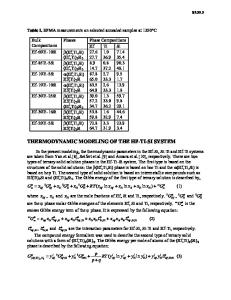Experimental Results and Modeling of the Codiffusion of Donors and Acceptors in Si
- PDF / 336,290 Bytes
- 6 Pages / 414.72 x 648 pts Page_size
- 81 Downloads / 386 Views
ABSTRACT A model based on ion pairing for the simulation of donor and acceptor codiffusion in silicon is presented. The proposed model allows us to obtain a good agreement with the experimental profiles over a wide range of diffusion conditions, specially at high concentrations where the standard process simulator codes give results strongly inaccurate. Comparison of the simulations with new and literature codiffusion profiles is provided.
INTRODUCTION The simulation of coupled dopant diffusion in silicon is becoming increasingly important in integrated circuit technology, as device dimensions are reduced and efforts are made to lower process complexity. Several recent papers reported investigations on donor and acceptor codiffusion [1-4]; these works evidence some anomalous behaviours related to a direct donoracceptor interaction, which are not predicted by the standard Fermi-level approach [5], and then are not considered by the most largely diffused process simulator codes, like SUPREM, PREDICT and STORM. The analyses of the As-B [4] and Sb-B [3] codiffusion results and the comparison with the corresponding data obtained for the diffusion of each element alone evidence the following main features: (a) the diffusivity of each dopant appears to be reduced. The amount of the effect can not be explained only on the basis of the Fermi level dependence of the diffusion coefficient [5]. (b) experiments were B and As (or Sb) are implanted with the same dose and projected range [3,4] show, at concentrations higher than about 1020 cm- 3 , a nearly coincident evolution of donor and acceptor profiles during thermal treatments. This is further confirmed by the SIMS profiles reported in Fig. 1 for samples co-implanted with As and B at a dose of lxl0 6 cm- 2 and annealed at 1000 C for different times. The two dopants seem travel together during annealing, moving with the same diffusivity; this in spite of the quite different behaviour they show when diffuse alone. (c) the carrier concentration in the region where donors and acceptors are present at very high density is significantly lower than the net difference between the equilibrium carrier concentrations exhibited by the two elements alone. Data for As-B and Sb-B are shown in Fig. 2. In order to explain these anomalous behaviours several authors [2-4,6,7] suggest the formation of bound pairs containing an acceptor and a donor atom. Wichert et al. [8], using the perturbed yy angular correlation technique, have provided direct evidence for the formation of InAs pairs in silicon specimens ion implanted with both these elements. In this work we present a model for the simulation of donors and acceptor codiffusion, based on three coupled diffusion equation: donors, acceptors, and ion pairs. A simulation program able to satisfactory describe the dopant profile evolution in a large range of annealing conditions has been developed. Comparisons with literature and new experimental data are provided. 65 Mat. Res. Soc. Symp. Proc. Vol. 389 01995 Materials Research Society
10 21
/
Data Loading...








